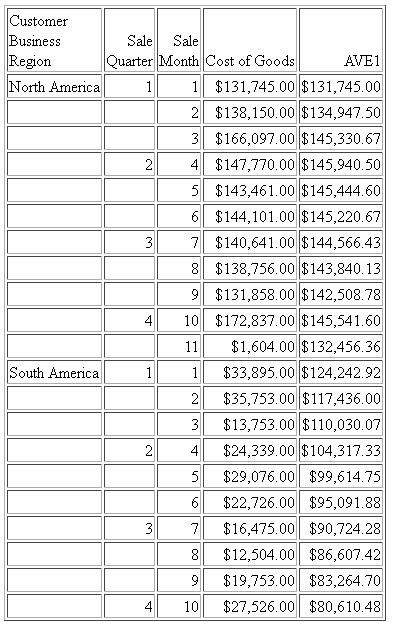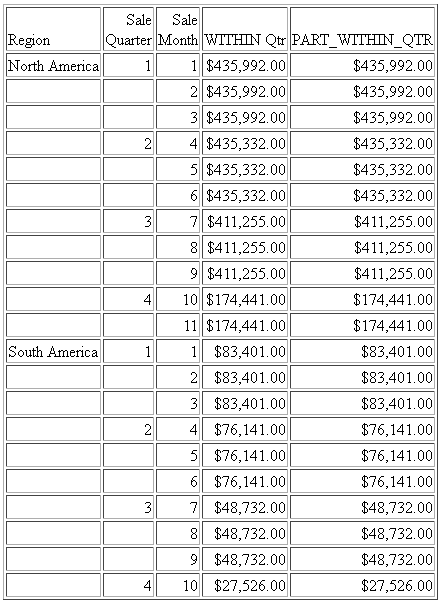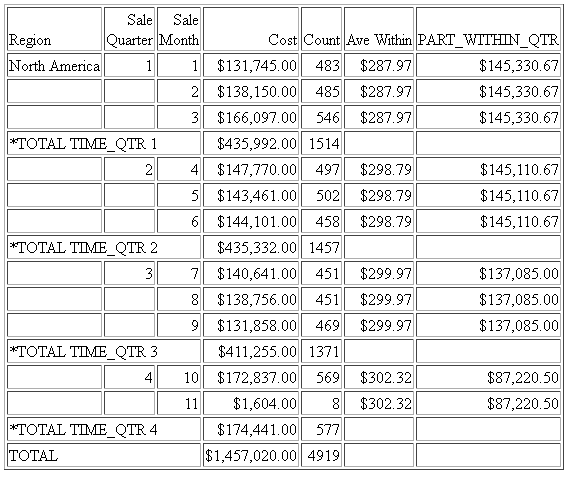Syntax: How to Generate Rolling Calculations Using PARTITION_AGGR
PARTITION_AGGR([prefix.]measure,{sortfield|TABLE},from,to,operation)where:
- prefix.
-
Defines an aggregation operator to apply to the measure before using it in the rolling calculation. Valid operators are:
- SUM. which calculates the sum of the measure field values. SUM is the default operator.
- CNT. which calculates a count of the measure field values.
- AVE. which calculates the average of the measure field values.
- MIN. which calculates the minimum of the measure field values.
- MAX. which calculates the maximum of the measure field values.
- FST. which retrieves the first value of the measure field.
- LST. which retrieves the last value of the measure field.
Note: The operators PCT., RPCT., TOT., MDN., and DST. are not supported. COMPUTEs that reference those unsupported operators are also not supported.
- measure
-
Is the measure field to be aggregated. It can be a real field in the request or a calculated value generated with the COMPUTE command, as long as the COMPUTE does not reference an unsupported prefix operator.
- sortfield
-
Is a BY or ACROSS field that defines the boundary of the partition. Operations will not cross a boundary. In the request the BY HIGHEST phrase to sort high-to-low is supported. ACROSS COLUMNS AND is also supported, but BY ROWS OVER and FOR are not supported.
Specifying TABLE as the boundary makes the partition boundary the entire internal matrix.
For example, if the sort is BY YEAR BY MONTH, with data from both 2014 and 2015, specifying the boundary as YEAR means that January 2015 - 2 will be valued as zero (0) or MISSING, as two months prior to January 2015 would cross the YEAR boundary. However, specifying TABLE as the boundary and requesting - 2 months would return the data for November 2014.
- from
-
Identifies the starting point for the rolling calculation. Valid values are:
- -n, which starts the calculation n rows back from the current row.
- B, which starts the calculation at the beginning of the current sort break (the first line with the same sort field value as the current line).
- to
-
Identifies the ending point of the rolling calculation. Valid values are:
- C, which ends the rolling calculation at the current row in the internal matrix.
- E, which ends the rolling calculation at the end of the sort break (the last line with the same sort value as the current row.)
- operation
-
Specifies the rolling calculation used on the values in the internal matrix. Supported operations are:
- SUM. which calculates a rolling sum.
- AVE. which calculates a rolling average.
- CNT. which counts the rows in the partition.
- MIN. which returns the minimum value in the partition.
- MAX, which returns the maximum value in the partition.
- FST. which returns the first value in the partition.
- LST. which returns the last value in the partition.
The calculation is performed prior to any WHERE TOTAL tests, but after any WHERE_GROUPED tests.
Example: Calculating a Rolling Average
The following request calculates a rolling average of the current line and the previous line in the internal matrix within the quarter.
TABLE FILE WF_RETAIL_LITE SUM COGS_US COMPUTE AVE1/D12.2M = PARTITION_AGGR(COGS_US, TIME_QTR, -1, C, AVE); BY BUSINESS_REGION BY TIME_QTR BY TIME_MTH WHERE BUSINESS_REGION EQ 'North America' OR 'South America' ON TABLE SET PAGE NOLEAD END
The output is shown in the following image. Within each quarter, the first average is just the value from Q1, as going back 1 would cross a boundary. The second average is calculated using the first two rows within that quarter, and the third average is calculated using rows 2 and 3 within the quarter.
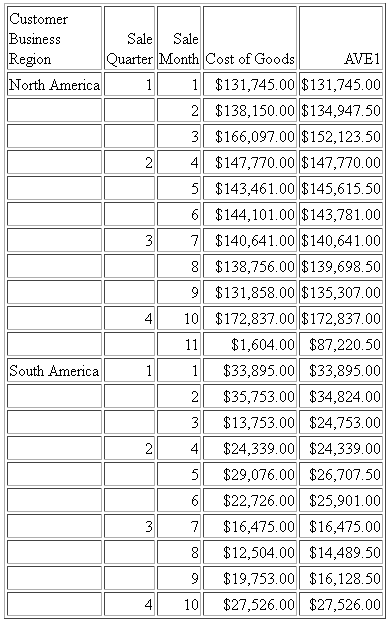
The following changes the rolling average to start from the beginning of the sort break.
COMPUTE AVE1/D12.2M = PARTITION_AGGR(COGS_US, TIME_QTR ,B, C, AVE);
The output is shown in the following image. Within each quarter, the first average is just the value from Q1, as going back would cross a boundary. The second average is calculated using the first two rows within that quarter, and the third average is calculated using rows 1 through 3 within the quarter.
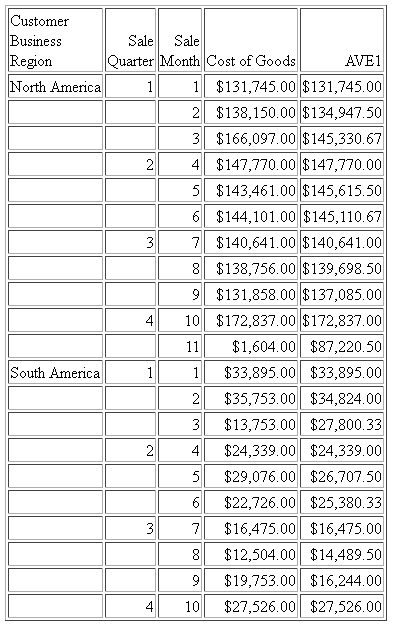
The following command uses the partition boundary TABLE.
COMPUTE AVE1/D12.2M = PARTITION_AGGR(COGS_US, TABLE, B, C, AVE);
The output is shown in the following image. The rolling average keeps adding the next row to the average until a break in the business region sort field.
